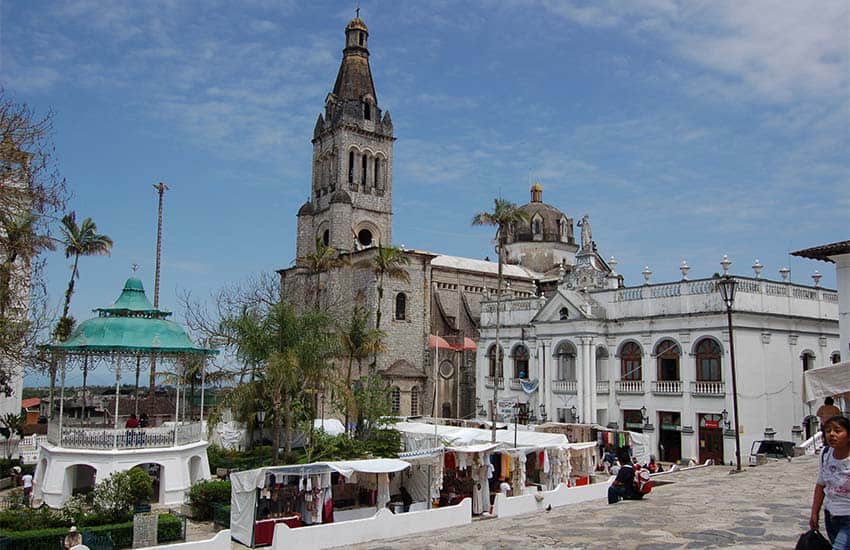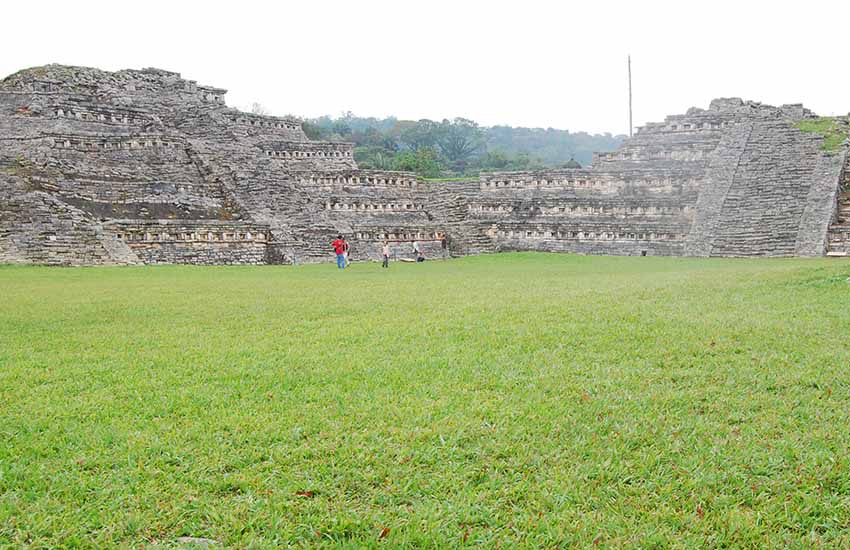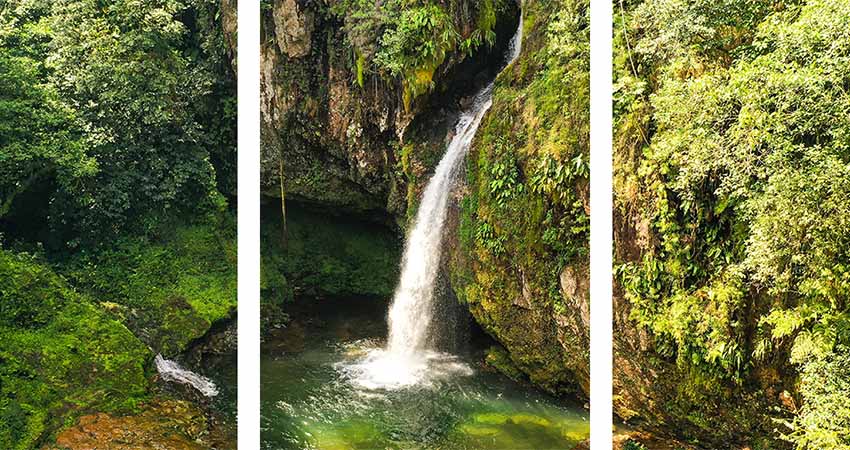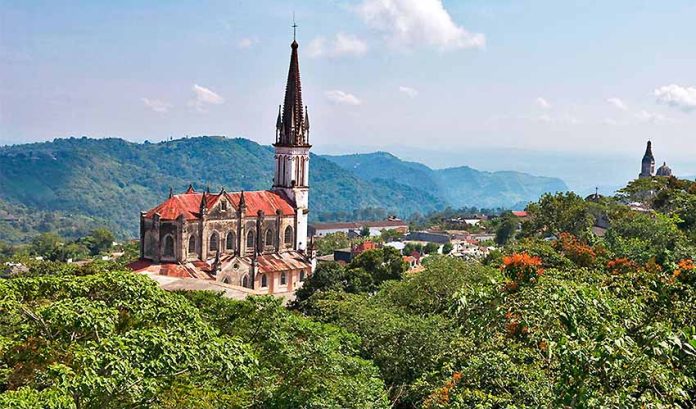Cuetzalan, a pueblo mágico about a four-hour drive from Puebla city, is one of those places that has something for just about everyone. The pueblo has winding cobblestone streets, a Sunday market, beautiful waterfalls, pre-Hispanic ruins and an abundance of excellent coffee.
For the more adventurous, there are also numerous caves to explore.

Cuetzalan is a Náhuatl name that has been translated a few different ways, but the most common is “Abundant Place of Quetzals.” The pueblo was founded by Franciscan friars in 1547, but the area surrounding it was settled over 1,000 years earlier.
It’s a small town, with a population of around 6,000, the majority of whom are Indigenous and speak Náhuatl or Totonac. Men will often be seen in traditional white shirts and pants while women wear white skirts and tops embroidered with colorful designs.
A major draw is its pre-Hispanic site, the ancient city of Yohualichan, a Náhuatl name meaning “House of the Night.” It’s about a 20-minute drive from Cuetzalan’s center.
The pyramids here surround a central ceremonial platform, and there is also court for pelota, the ancient ballgame played by many pre-Hispanic peoples throughout Mesoamerica.
Yohualichan’s construction is believed to have been started by the Totonacans around A.D. 200. The civilization reached its peak around A.D. 600 before declining somewhere around A.D. 800–900.
The excavated pyramids, with their rows of niches, are identical in design to Tajín, a larger site in Veracruz also built by the Totanacans.
I was taken to the ruins by my guide, Polo Hernández. I asked him how the site was rediscovered. He told me it was found when residents, upon hearing cries and moans, went to investigate.
I’m not sure if they continue to hear such sounds but I didn’t hear any during my visit. Maybe you will. The site is open Tuesday–Saturday, 9 a.m.–5 p.m. There’s a 65-peso entrance fee.

Overlooking Cuetzalan’s center is the Parroquia de San Francisco, a Renaissance-style 16th-century church that boasts the tallest tower in the state of Puebla. In front of the church, locals set up stalls where they sell a variety of handicrafts and other goods.
The steps ringing the center are often lined with people selling their produce. In my experience, most of the people are older and speak little or no Spanish.
A short distance away from the center is another church, the Santuario de Guadalupe, also known as the Church of the Jarritos. It gets its nickname from the small terracotta jugs (jarritos) that decorate its spire. In front of the church is a large cemetery.
Cuetzalan is often foggy, enveloping the graves in a mist that give them a sense of mystery. Or maybe it’s foreboding.
The pueblo’s population swells on Sundays when there’s a tianguis, a weekly market. People come in from nearby towns and set up stalls where they’ll sell produce, foods, handicrafts and other items.
The Calmahuistic Ethnographic Museum is small but worth a visit. It’s not far from Cuetzalan’s center, and it has rooms filled with pre-Hispanic figures and pottery, traditional costumes and instruments.
Another feature of Cuetzalan is that its surrounded area is dotted with waterfalls, the most popular of which is La Cascada de las Brisas, about a 20-minute drive away from town. I walked with Hernández to a series of smaller waterfalls. The trail we took to and from the waterfalls was made from stones that, he said, had been laid over 700 years ago by Totonacans.
![]()
Hernández is a volador, a member of a group that performs a traditional ceremony associated with fertility rites, and I got a chance to observe his group at work.
During the ceremony, five voladores climb a 30-meter pole. One member, the caporal (chief), dances on a small stand atop the pole while playing a flute and tapping on a small drum.
At the end of the dance, the other four members, who all this time have been sitting on a platform surrounding the stand, tip back and fall to the earth, saved from serious injury or death only by a rope tied around the upper part of one leg that ensures they land safely.
I asked Hernández if they learn to perform this ritual by first climbing up shorter poles.
“No,” he said matter-of-factly. “We just climb up the tall pole.”
I mentioned at the beginning that Cuetzalan has a multitude of caves, making it a popular spot for cavers. However, these caves should only be explored with an experienced guide.

Many people in Cuetzalan’s surrounding pueblos grow coffee and belong to the fair-trade cooperative Tosepan Titataniske, a Náhuatl phrase meaning “Together We Will Overcome.” Fair-trade coops pay farmers more for their coffee. People also harvest black pepper and many keep bees — a small variety that lacks stingers and produces honey with a slightly vinegary taste.
The coop also runs Tosepan Kali, an ecotourism site that offers a hotel and cabins set among a lush orchard.
There are plenty of places to eat in Cuetzalan, offering everything from traditional Mexican fare to pizza and pasta. One of my favorite street foods there are tayoyos (also called tlacoyos). It’s a thick corn tortilla generally filled with beans and then fried.
Finally, be aware that Cuetzalan is humid, and there are sometimes days when there’s a steady drizzle and it’s often foggy. So check the forecast, and rain gear’s a must. Its streets and sidewalks are made of stone and when wet, can be slippery, so caution must be paid when walking.
Joseph Sorrentino, a writer, photographer and author of the book San Gregorio Atlapulco: Cosmvisiones and of Stinky Island Tales: Some Stories from an Italian-American Childhood, is a regular contributor to Mexico News Daily. More examples of his photographs and links to other articles may be found at www.sorrentinophotography.com He currently lives in Chipilo, Puebla.
